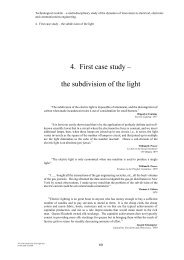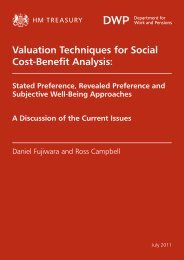NAO Good Practice Guide - Tackling external fraud - HM Treasury
NAO Good Practice Guide - Tackling external fraud - HM Treasury
NAO Good Practice Guide - Tackling external fraud - HM Treasury
Create successful ePaper yourself
Turn your PDF publications into a flip-book with our unique Google optimized e-Paper software.
4 <strong>Good</strong> practice in tackling <strong>external</strong> <strong>fraud</strong> | Understanding and managing the risks of <strong>fraud</strong><br />
1.8 Points to consider for statistical modelling are:<br />
l The data required may be incomplete.<br />
The model may use therefore a number of<br />
assumptions which mean that the results are<br />
subject to a margin of error. It is important to<br />
take this into account when making decisions<br />
on actions to reduce losses.<br />
l Other work may be needed to give an insight<br />
into those committing the <strong>fraud</strong> or the type of<br />
action that might deter them. This may include<br />
more in depth modelling work (see Figure<br />
on the BBC).<br />
l Further research may be needed into the<br />
causes of increases or decreases in the level<br />
of losses and the extent to which this is due to<br />
anti-<strong>fraud</strong> measures implemented.<br />
Sampling<br />
1.9 Estimates of loss can be generated by<br />
checking a representative sample of cases to see<br />
whether <strong>fraud</strong> is involved, and extrapolating the<br />
results to the whole population to estimate the<br />
total level of <strong>fraud</strong> loss in the area of expenditure<br />
or revenue (Figure 8). When checking individual<br />
cases it can be difficult to determine whether any<br />
discrepancy is due to <strong>fraud</strong> or error (recklessness,<br />
carelessness or ignorance) because of the<br />
judgements that need to be made. In its work in<br />
estimating <strong>fraud</strong> in individual expenditure streams,<br />
the NHS Counter Fraud Service is deciding<br />
whether <strong>fraud</strong> is involved by using the concept of<br />
<strong>fraud</strong> and burden of proof applicable in civil law<br />
– that is whether someone knowingly or recklessly<br />
obtained resources to which they were not entitled<br />
and the balance of probability. This is to ensure<br />
that all behaviour which can legally be determined<br />
as <strong>fraud</strong> is measured.<br />
Figure 8<br />
The Driver and Vehicle Licensing Agency<br />
use sampling to estimate the amount of<br />
evasion of Vehicle Excise Duty<br />
The Department for Transport commissions a roadside<br />
survey of over one million passing vehicles annually<br />
in June to identify unlicensed vehicles. Statistical<br />
weightings are then applied to the observed evasion<br />
rate in traffic to calculate the estimated evasion in the<br />
overall stock of vehicles, and then the estimated Vehicle<br />
Excise Duty revenue loss. The results are used to report<br />
performance against targets for the Department and the<br />
Driver and Vehicle Licensing Agency.<br />
1.10 A key consideration in producing an estimate<br />
of <strong>fraud</strong> loss on an area of expenditure/revenue is<br />
the level of accuracy required. A greater degree of<br />
precision produces more reliable estimates (essential<br />
for assessing any real change in the level of <strong>fraud</strong><br />
over time) but at additional cost because the size of<br />
the sample required increases (Figure 9).<br />
Figure 9<br />
Generating precise estimates of <strong>fraud</strong><br />
requires larger sample sizes and incurs<br />
higher measurement costs<br />
The degree of precision of a <strong>fraud</strong> loss estimate<br />
depends on:<br />
l the size of the sample checked. For example, the<br />
NHS Counter Fraud Service set sample sizes so<br />
that they can determine the level of <strong>fraud</strong> in each<br />
area to within to +/- one per cent;<br />
l whether the sample is stratified according to the<br />
type of risk;<br />
l use of skilled reviewers able to detect where <strong>fraud</strong><br />
has occurred, the amount of loss suffered and the<br />
nature of the <strong>fraud</strong>;<br />
l the quality control and validation arrangements<br />
to ensure the review process is correctly and<br />
consistently applied.





![AIRTO [Professor Dr Brian Blunden] - HM Treasury](https://img.yumpu.com/15492848/1/184x260/airto-professor-dr-brian-blunden-hm-treasury.jpg?quality=85)










